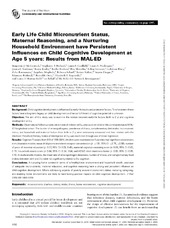| dc.contributor.author | McCormick, Benjamin J.J. | |
| dc.contributor.author | Richard, Stephanie A. | |
| dc.contributor.author | Caulfield, Laura E. | |
| dc.contributor.author | Pendergast, Laura L. | |
| dc.contributor.author | Seidman, Jessica C. | |
| dc.contributor.author | Koshy, Beena | |
| dc.contributor.author | Roshan, Reeba | |
| dc.contributor.author | Shrestha, Rita | |
| dc.contributor.author | Svensen, Erling | |
| dc.contributor.author | Blacy, Ladislaus | |
| dc.contributor.author | Rasmussen, Zeba | |
| dc.contributor.author | Maphula, Angelina | |
| dc.contributor.author | Scharf, Rebecca | |
| dc.contributor.author | Nahar, Baitun | |
| dc.contributor.author | Haque, Sayma | |
| dc.contributor.author | Rasheed, Muneera | |
| dc.contributor.author | Oria, Reinaldo | |
| dc.contributor.author | Rogawski, Elizabeth T. | |
| dc.contributor.author | Murray-Kolb, Laura E. | |
| dc.date.accessioned | 2020-06-30T12:39:34Z | |
| dc.date.available | 2020-06-30T12:39:34Z | |
| dc.date.issued | 2019 | |
| dc.Published | McCormick BJ, Richard SA, Caulfield LE, Pendergast LL, Seidman JC, Koshy B, Roshan R, Shrestha R, Svensen E, Blacy L, Rasmussen Z, Maphula A, Scharf R, Nahar B, Haque, Rasheed M, Oria, Rogawski ET, Murray-Kolb LE. Early life child micronutrient status, maternal reasoning, and a nurturing household environment have persistent influences on child cognitive development at age 5 years: Results from MAL-ED. Journal of Nutrition. 2019;149(8):1460-1469 | eng |
| dc.identifier.issn | 0022-3166 | |
| dc.identifier.issn | 1541-6100 | |
| dc.identifier.uri | https://hdl.handle.net/1956/23108 | |
| dc.description.abstract | Background: Child cognitive development is influenced by early-life insults and protective factors. To what extent these factors have a long-term legacy on child development and hence fulfillment of cognitive potential is unknown. Objective: The aim of this study was to examine the relation between early-life factors (birth to 2 y) and cognitive development at 5 y. Methods: Observational follow-up visits were made of children at 5 y, previously enrolled in the community-based MAL-ED longitudinal cohort. The burden of enteropathogens, prevalence of illness, complementary diet intake, micronutrient status, and household and maternal factors from birth to 2 y were extensively measured and their relation with the Wechsler Preschool Primary Scales of Intelligence at 5 y was examined through use of linear regression. Results: Cognitive T-scores from 813 of 1198 (68%) children were examined and 5 variables had significant associations in multivariable models: mean child plasma transferrin receptor concentration (β: −1.81, 95% CI: −2.75, −0.86), number of years of maternal education (β: 0.27, 95% CI: 0.08, 0.45), maternal cognitive reasoning score (β: 0.09, 95% CI: 0.03, 0.15), household assets score (β: 0.64, 95% CI: 0.24, 1.04), and HOME child cleanliness factor (β: 0.60, 95% CI: 0.05, 1.15). In multivariable models, the mean rate of enteropathogen detections, burden of illness, and complementary food intakes between birth and 2 y were not significantly related to 5-y cognition. Conclusions: A nurturing home context in terms of a healthy/clean environment and household wealth, provision of adequate micronutrients, maternal education, and cognitive reasoning have a strong and persistent influence on child cognitive development. Efforts addressing aspects of poverty around micronutrient status, nurturing caregiving, and enabling home environments are likely to have lasting positive impacts on child cognitive development. | en_US |
| dc.language.iso | eng | eng |
| dc.publisher | Oxford University Press | eng |
| dc.rights | Attribution CC BY | eng |
| dc.rights.uri | http://creativecommons.org/licenses/by/4.0/ | eng |
| dc.title | Early life child micronutrient status, maternal reasoning, and a nurturing household environment have persistent influences on child cognitive development at age 5 years: Results from MAL-ED | eng |
| dc.type | Peer reviewed | |
| dc.type | Journal article | |
| dc.date.updated | 2020-02-04T13:00:20Z | |
| dc.description.version | publishedVersion | |
| dc.rights.holder | Copyright American Society for Nutrition 2019 | eng |
| dc.identifier.doi | https://doi.org/10.1093/jn/nxz055 | |
| dc.identifier.cristin | 1749865 | |
| dc.source.journal | Journal of Nutrition | |

